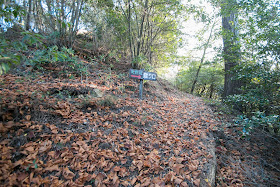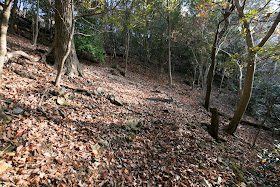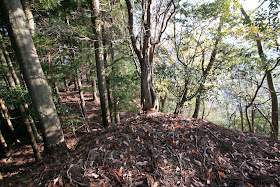Ikuno Castle
-Castle protected strategic silver mine-
Overview
Name: Ikuno castle (Ikuno-jo)
Alias:
Place: Ikunocho Asago city, Hyogo
Location: 35.17220260667435, 134.79980536589412
Type: Mountain Castle
Built: 15th century
Remaining remnants: Stone walls and clay walls
Title:
Ikuno Castle (生野城) is located on Kojosan mountain, one of about 300 meter height from hillside at the backside of current Ikuno town. Ikuno town is one of the central watershed areas of Japan, where Ichikawa river which flows from eastward turned southward toward Seto-Naikai sea, and Maruyama-gawa river starts just the north of town to the Sea of Japan.
As the height of Ikuno area is not so high and both river runs straightly, this area works as a corridor connects Himeji area and Toyooka area, which are entrance into Sanyo region and Sanin region respectively from Kinki region. Even now Bantan-sen line, highway and national road runs this small valley.
In addition to this, just aside of the road, there was Ikuno silver mine which had been one of the three largest mines of Japan along with Iwami silver mine (Shimane prefecture) and Sado gold mine (Niigata prefecture). Currently there is no clear volcano in this area but due to the ancient volcanic activity minerals arouse around Ikuno area and there were several mines other than Ikuno silver mine at neighbor place.
Ikuno castle was originally built by Tokihiro Yamana (1367-1435), the leader of Yamana clan which governed Tajima province (northwest part of Hyogo prefecture) and lord of Konosumiyama castle (Hyogo prefecture). Around that time the conflict between Muromachi Shogunate and Akamatsu clan which was the governor of Harima province (south half of Hyogo prefecture) arouse, and Yamana clan intended to guard the border preparing for the incident.
Yamana clan became its peak under Sozen Yamana (1404-1473) and became the leader of the West army in the battle of Onin continued from 1467-1477 at Kyoto city. But in addition to the burden of long battle, internal conflicts arouse in the clan thus the power of Yamana clan significantly declined. Harima province once kept by Yamana clan was deprived by Akamatsu clan again, and distant Bingo province was under the control of Ouchi clan.
Furthermore, even in Tajima province where was the main territory of Yamana clan, local lords such as Kakiya clan and Tainosho clan at Toyotoka area, Yagi clan at Yabu area or Otagaki clan at Asago area. Otagaki clan was placed as the commander of Takeda castle (Hyogo prefecture) at the north of Ikuno area, became half independent at that area.
In 1542, silver mineral was found just the below of Ikuno castle, and Ikuno Silver mine started operation under the technology of continent brought through Iwami Silver mine. Suketoyo Yamana (1551-1580), the leader of Yamana clan, strengthened Ikuno castle to protect silver mine, and also built hillside residence for administration.
Suketoyo Yamana temporary activated his military operation based on the gain achieved from silver mine and once reformed Yamana clan into the warlord of Tajima province and Inaba province (east half of Tottori prefecture). But internally Yamana clan held small territory around their main base Konosumiyama castle at Izushi area.
In 1567, Ikuno silver mine was deprived by Otagaki clan, which was the commander of Takeda castle. Two years later Hideyoshi Hashiba (1537-1598, later Hideyoshi Toyotomi), who was still the commander of central ruler Nobunaga Oda (1534-1582), intruded into Tajima province. Hideyoshi forced Yamana clan to subordinate to Nobunaga and captured Ikuno area including castle and silver mine.
However in 1571, Naomasa Akai (1529-1578), a brave local lord of Kuroi castle (Hyogo prefecture) known as “red devil of Tanba province), stroke back the intrusion of Yamana army and reversely invaded into Tajima province and reversely captured Takeda castle. Akai clan might held Ikuno Silver mine this time, but Nobunaga faced strong enemies such as Asakura clan, Azai clan or Takeda clan could not cope with it this time.
In 1575, Mitsuhide Akechi (1528-1582), the general of Nobunaga, started his campaign at Tanba province. Once defeated by the alliance of Akai clan and Hatano clan, Mitsuhide finally ruined both clans in 1579 and captured Tanba province. At the same time, the conflict between Oda clan and Mouri clan which was the ruler of Chugoku region arouse, and Tajima province became the front line of both powers.
Yamana clan once belonged to Oda clan but their major retainers turned to Mouri clan then had to follow this. In response to this, Nobunaga sent Hideyoshi to Tajima province again, to seize Tajima province and Ikuno Silver mine. After several years battle Hideyoshi ruined Yamana clan and their retainers then captured Tajima province in 1579.
At that time Hideyoshi had to fight with Mouri clan at both of Sanin region and Sanyo region, and Ikuno area was only one connecting route between Himeji castle (Hyogo prefecture), the main base of Hideyoshi, and Arikoyama castle (Hyogo prefecture) which was the base of Hidenaga Hashiba (1540-1591), the younger brother of Hideyoshi and commander in Sanin region. To protect this important communication line and Ikuno silver mine, Hideyoshi further reformed Ikuno castle.
Ikuno castle spreads peak of over corn shaped mountain. Central area of the castle is a trapezoid shaped one of about 30 meter long and 20 meter wide, which might have main building at its southeastern corner. At the west of central area, there is a secondary area that is a rectangular one of about 50 meter long and 30 meter wide, which might be used as the ground of hilltop residence and has folded gate protected by stone walls.
Ahead of secondary area, third area and other areas are built at western slope of the mountain. From western edge of hilltop area ridges separate into northwest one and south west one, and several terraces were built at both ridges. Now stone walls scarcely remain but considering the shape of edge and remaining stones core areas might be wholly covered by stone walls.
At the north slope of central area, there are several layers of areas securely protected by combination of deep dry moat, clay wall and ground of turrets. This area is a weak point of the castle connecting to backside mountains thus might be added at the renovation by Hideyoshi. Total size of the castle is about 400 meter long and 300 meter wide, and considering sheer slope of the mountain it could show sufficient defense ability.
In 1580, Ukita clan which was the warlord of Bizen province (southeast part of Okayama prefecture) turned to Hideyoshi, and next year Hideyoshi fell Tottori castle (Tottori prefecture). Then the front line moved westward then threat to Ikuno area significantly decreased. Around this time Hideyoshi fell castles such as Tottori castle or Bicchu Takamatsu castle (Okayama prefecture) by encirclement with huge construction and this could be achieved by the fund from silver mine.
After the incident of Honnoji in 1582, a coup d’etat of Mitsuhide Akechi against Nobunaga Oda, Hideyoshi broke Mitsuhide at the battle of Yamazaki and became next ruler. Hideyoshi directly held Ikuno Silver mine but recognized no necessity to use Ikuno castle, then Ikuno castle might be abolished at this point and stones were used to expand hillside offices.
Instead of this, Hideyoshi thoroughly strengthened Takeda castle and Himeji castle as the guard of Ikuno Silver mine at the both side of corridor. Considering the protection of Sanindo road from Chugoku region, Yagi area is more appropriate than Takeda castle to stop the enemy just passed the mountains. But even though at a backside, Takeda castle is expected to protect both of Sanindo road and corridor to Ikuno area.
Different from Iwami Silver mine which became exhausted by the middle of Edo era, Ikuno silver mine continued its operation to 20th century, changing its product from silver to copper or tin and supported the finance of Edo Shogunate or Meiji new government. Reflecting its long history, remnants from medieval era to modern era widely remain.
Now no building is left but structure of the castle well remain on the mountain with scarcely remaining stone walls. Holes of roadway remain at the entrance of climbing road and this exactly shows the raison d’etre of the castle. Activity of Ikuno town significantly changed from the past, but foggy scenery of the valley seen from castle site is unchanged.
20 minutes walk from JR West Bantan-sen line Ikuno station to entrance of climbing road and 45 minutes walk from hillside to hilltop castle. 15 minutes drive from Banran-Renraku Doro Expressway Ikuno-kita Daiichi interchange.
Konosumiyama Castle -10 year battle at capital city for the purpose of battle itself-
Takeda Castle -Castle guarded vital area of Toyotomi government-
Kuroi Castle -Castle of red devil of Tanba province-
Himeji Castle (1) -Castle of good combination of commander and staff-
Arikoyama castle and Izushi Castle -Castle looking down small basin from high place-
Type: Mountain Castle
Built: 15th century
Remaining remnants: Stone walls and clay walls
Title:
Brief History
Ikuno Castle (生野城) is located on Kojosan mountain, one of about 300 meter height from hillside at the backside of current Ikuno town. Ikuno town is one of the central watershed areas of Japan, where Ichikawa river which flows from eastward turned southward toward Seto-Naikai sea, and Maruyama-gawa river starts just the north of town to the Sea of Japan.
As the height of Ikuno area is not so high and both river runs straightly, this area works as a corridor connects Himeji area and Toyooka area, which are entrance into Sanyo region and Sanin region respectively from Kinki region. Even now Bantan-sen line, highway and national road runs this small valley.
In addition to this, just aside of the road, there was Ikuno silver mine which had been one of the three largest mines of Japan along with Iwami silver mine (Shimane prefecture) and Sado gold mine (Niigata prefecture). Currently there is no clear volcano in this area but due to the ancient volcanic activity minerals arouse around Ikuno area and there were several mines other than Ikuno silver mine at neighbor place.
Origin of Ikuno castle
Ikuno castle was originally built by Tokihiro Yamana (1367-1435), the leader of Yamana clan which governed Tajima province (northwest part of Hyogo prefecture) and lord of Konosumiyama castle (Hyogo prefecture). Around that time the conflict between Muromachi Shogunate and Akamatsu clan which was the governor of Harima province (south half of Hyogo prefecture) arouse, and Yamana clan intended to guard the border preparing for the incident.
Yamana clan became its peak under Sozen Yamana (1404-1473) and became the leader of the West army in the battle of Onin continued from 1467-1477 at Kyoto city. But in addition to the burden of long battle, internal conflicts arouse in the clan thus the power of Yamana clan significantly declined. Harima province once kept by Yamana clan was deprived by Akamatsu clan again, and distant Bingo province was under the control of Ouchi clan.
Furthermore, even in Tajima province where was the main territory of Yamana clan, local lords such as Kakiya clan and Tainosho clan at Toyotoka area, Yagi clan at Yabu area or Otagaki clan at Asago area. Otagaki clan was placed as the commander of Takeda castle (Hyogo prefecture) at the north of Ikuno area, became half independent at that area.
Development and struggle of silver mine
In 1542, silver mineral was found just the below of Ikuno castle, and Ikuno Silver mine started operation under the technology of continent brought through Iwami Silver mine. Suketoyo Yamana (1551-1580), the leader of Yamana clan, strengthened Ikuno castle to protect silver mine, and also built hillside residence for administration.
Suketoyo Yamana temporary activated his military operation based on the gain achieved from silver mine and once reformed Yamana clan into the warlord of Tajima province and Inaba province (east half of Tottori prefecture). But internally Yamana clan held small territory around their main base Konosumiyama castle at Izushi area.
In 1567, Ikuno silver mine was deprived by Otagaki clan, which was the commander of Takeda castle. Two years later Hideyoshi Hashiba (1537-1598, later Hideyoshi Toyotomi), who was still the commander of central ruler Nobunaga Oda (1534-1582), intruded into Tajima province. Hideyoshi forced Yamana clan to subordinate to Nobunaga and captured Ikuno area including castle and silver mine.
However in 1571, Naomasa Akai (1529-1578), a brave local lord of Kuroi castle (Hyogo prefecture) known as “red devil of Tanba province), stroke back the intrusion of Yamana army and reversely invaded into Tajima province and reversely captured Takeda castle. Akai clan might held Ikuno Silver mine this time, but Nobunaga faced strong enemies such as Asakura clan, Azai clan or Takeda clan could not cope with it this time.
Seizure by Hideyoshi Toyotomi
In 1575, Mitsuhide Akechi (1528-1582), the general of Nobunaga, started his campaign at Tanba province. Once defeated by the alliance of Akai clan and Hatano clan, Mitsuhide finally ruined both clans in 1579 and captured Tanba province. At the same time, the conflict between Oda clan and Mouri clan which was the ruler of Chugoku region arouse, and Tajima province became the front line of both powers.
Yamana clan once belonged to Oda clan but their major retainers turned to Mouri clan then had to follow this. In response to this, Nobunaga sent Hideyoshi to Tajima province again, to seize Tajima province and Ikuno Silver mine. After several years battle Hideyoshi ruined Yamana clan and their retainers then captured Tajima province in 1579.
At that time Hideyoshi had to fight with Mouri clan at both of Sanin region and Sanyo region, and Ikuno area was only one connecting route between Himeji castle (Hyogo prefecture), the main base of Hideyoshi, and Arikoyama castle (Hyogo prefecture) which was the base of Hidenaga Hashiba (1540-1591), the younger brother of Hideyoshi and commander in Sanin region. To protect this important communication line and Ikuno silver mine, Hideyoshi further reformed Ikuno castle.
Structure of Ikuno castle
Ikuno castle spreads peak of over corn shaped mountain. Central area of the castle is a trapezoid shaped one of about 30 meter long and 20 meter wide, which might have main building at its southeastern corner. At the west of central area, there is a secondary area that is a rectangular one of about 50 meter long and 30 meter wide, which might be used as the ground of hilltop residence and has folded gate protected by stone walls.
Ahead of secondary area, third area and other areas are built at western slope of the mountain. From western edge of hilltop area ridges separate into northwest one and south west one, and several terraces were built at both ridges. Now stone walls scarcely remain but considering the shape of edge and remaining stones core areas might be wholly covered by stone walls.
At the north slope of central area, there are several layers of areas securely protected by combination of deep dry moat, clay wall and ground of turrets. This area is a weak point of the castle connecting to backside mountains thus might be added at the renovation by Hideyoshi. Total size of the castle is about 400 meter long and 300 meter wide, and considering sheer slope of the mountain it could show sufficient defense ability.
Change of defense structure
In 1580, Ukita clan which was the warlord of Bizen province (southeast part of Okayama prefecture) turned to Hideyoshi, and next year Hideyoshi fell Tottori castle (Tottori prefecture). Then the front line moved westward then threat to Ikuno area significantly decreased. Around this time Hideyoshi fell castles such as Tottori castle or Bicchu Takamatsu castle (Okayama prefecture) by encirclement with huge construction and this could be achieved by the fund from silver mine.
After the incident of Honnoji in 1582, a coup d’etat of Mitsuhide Akechi against Nobunaga Oda, Hideyoshi broke Mitsuhide at the battle of Yamazaki and became next ruler. Hideyoshi directly held Ikuno Silver mine but recognized no necessity to use Ikuno castle, then Ikuno castle might be abolished at this point and stones were used to expand hillside offices.
Instead of this, Hideyoshi thoroughly strengthened Takeda castle and Himeji castle as the guard of Ikuno Silver mine at the both side of corridor. Considering the protection of Sanindo road from Chugoku region, Yagi area is more appropriate than Takeda castle to stop the enemy just passed the mountains. But even though at a backside, Takeda castle is expected to protect both of Sanindo road and corridor to Ikuno area.
Afterward of mine and castle
Different from Iwami Silver mine which became exhausted by the middle of Edo era, Ikuno silver mine continued its operation to 20th century, changing its product from silver to copper or tin and supported the finance of Edo Shogunate or Meiji new government. Reflecting its long history, remnants from medieval era to modern era widely remain.
Now no building is left but structure of the castle well remain on the mountain with scarcely remaining stone walls. Holes of roadway remain at the entrance of climbing road and this exactly shows the raison d’etre of the castle. Activity of Ikuno town significantly changed from the past, but foggy scenery of the valley seen from castle site is unchanged.
Access
20 minutes walk from JR West Bantan-sen line Ikuno station to entrance of climbing road and 45 minutes walk from hillside to hilltop castle. 15 minutes drive from Banran-Renraku Doro Expressway Ikuno-kita Daiichi interchange.
Related Castles
Konosumiyama Castle -10 year battle at capital city for the purpose of battle itself-
Takeda Castle -Castle guarded vital area of Toyotomi government-
Kuroi Castle -Castle of red devil of Tanba province-
Himeji Castle (1) -Castle of good combination of commander and staff-
Arikoyama castle and Izushi Castle -Castle looking down small basin from high place-

































































































































































No comments:
Post a Comment